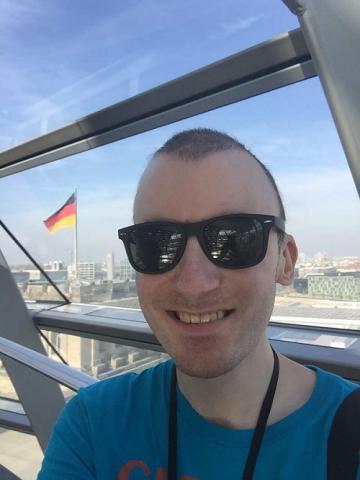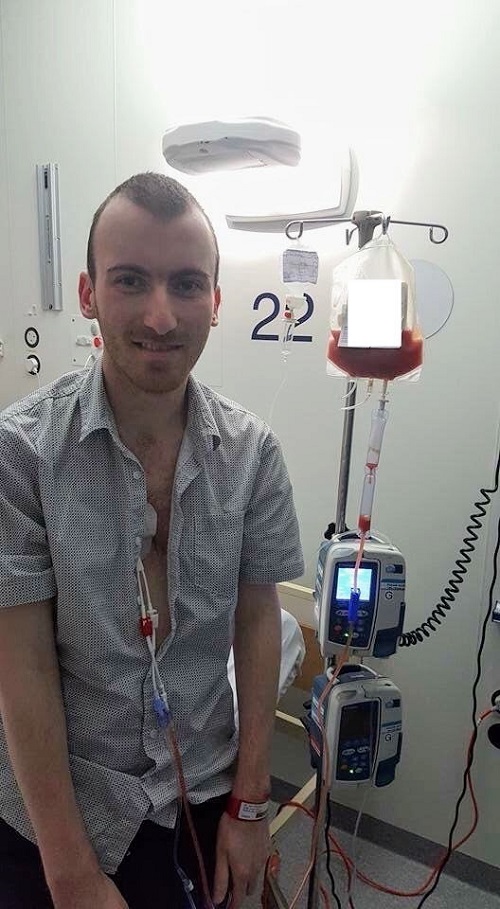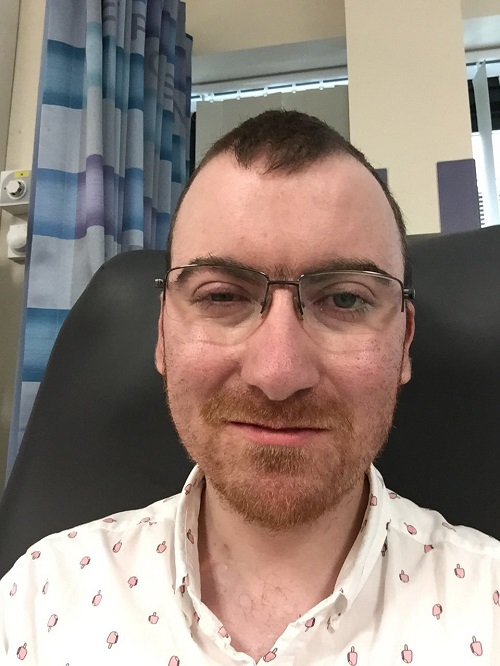Sam was only three years old when he started to experience fatigue and bruising and was diagnosed with aplastic anaemia. He was treated with immunosuppressants, but 17 years later he was also diagnosed with myelodysplastic syndrome (MDS) and was told he’d need a stem cell transplant.
After his transplant, Sam has experienced graft versus host disease (GvHD), a common side effect of transplant, and is now receiving Extracorporeal Photopheresis (ECP) to treat it. Sam spoke to Clare in our Patient Services team about his experience of ECP, what life is like for him now and advice he has for other patients.
What was it like to have your stem cell transplant?
Initially, it all happened quite quickly. It only took six weeks for Anthony Nolan to find a donor for me, which I was really surprised at. My donor is a German man who is 45 years old and I'm incredibly grateful for what he did.
The transplant itself was a tough process - the chemotherapy before was unpleasant, and it was a new experience for me. Thankfully, side effects were all under control.
On day zero of the stem cell transplant, I was surprised at how quick it was - it felt like a blood transfusion. On the day, I felt disoriented and had some breathing difficulties, but this subsided.
During my isolation, I managed to cope using social media to contact the outside world and my friends. My family also visited and were careful about infection control. I used to take photographs of myself to let people know what it’s like. Now these photos are an interesting resource for me to reflect on.
After discharge, the recovery was a long and difficult process, as I was readmitted quite a few times for viral infections. Thankfully I recovered well from those.
You’ve developed some graft versus host disease (GvHD) side effects following your transplant, how do they impact you?
I developed GvHD of the gut and I have chronic skin GvHD. However, of all side effects, fatigue was the biggest one for me to deal with. Fatigue was quite difficult to get used to as for 17 years, I lived a healthy normal life, then to suddenly be so fatigued and constantly have no energy, this was a really difficult change for me.
You’re now receiving ECP to help treat the GvHD side effects. For anyone who doesn’t know, can you tell us what ECP is and what it’s like to have ECP treatment?
ECP is also called extracorporeal photopheresis. ECP is a treatment for GvHD which is designed to destroy the T cells and white blood cells which cause the GvHD.
The process is very similar to how stem cells are collected for donation. The machine collects blood from one arm, which goes into a machine which separates out the T cells and white blood cells causing the GvHD reaction, then the rest of the blood circulates back into the blood in the other arm.
Then the white blood cells collected by the machine are mixed with a medication which is sensitive to ultraviolet (UV) light. All of that is mixed together and then exposed to UV light. As it reacts, the white cells that are causing GvHD are destroyed, before the cells are reinfused back into your body. This triggers your immune system to carry on doing this, to destroy GvHD cells in your blood. It's a very complicated mechanism but it’s amazing really.
I find it really relaxing! The machine itself can be a bit noisy, but you get used to it and you’re looked after well. You’re in a comfortable chair that reclines, and you’re kept comfortable so it’s nothing to worry about. You can have someone with you too, you can still eat and drink which isn’t a problem. One thing is you have to stay connected all the way through, so it’s just something to bear in mind too as takes about one to two hours
What impact does the ECP have on your normal life?
You have the ECP over two consecutive days, every two weeks for the first three months. Now, I have it once a month. One of the important things to remember for those with chronic skin GvHD - ECP can take a while to get a response, it was about six months before I started to see an improvement.
It is very safe treatment - some people do worry about it, but I experienced very few side effects. The main side effect is looking tired a few days after, but this doesn’t stop me enjoying myself or going about my daily life, which is good.
As you’re exposed to UV light, you have to wear sun cream for a few days after as you are extremely sensitive to sunlight. I also change my diet one day before the ECP, as it’s recommended to have a low-fat diet as if you have too much fat or cholesterol in your blood stream, it can affect how the treatment works. So, I’ve added this to my routine, but it’s very manageable.
Progress is also reviewed regularly so the time scales for the treatment can change and it’s very case-by-case basis - some may respond quicker than others.
Did you have any concerns or worries about starting ECP?
The thought of having to reschedule life was daunting, but it becomes part of your routine really. I remember I went to an Anthony Nolan Patient and Family GvHD education day in 2018 and the topic of ECP came up. I spoke to some patients there who had it, and some were finding it difficult. I’ll be honest, at that point I wasn’t sure if I would be keen to go through with it.
However, Naomi, my Anthony Nolan CNS chatted through it all and introduced me to the nurses who work with ECP and I saw the process taking place which helped get rid of my worries. It was like any treatment that’s new - a bit daunting, but I have found it easy to deal with.
As you’re going for the same treatment so regularly, I often see the same people each time and we form friendships. It’s a wonderful supportive environment in the ECP unit.
It’s really good to hear it’s been going OK for you! How is life for you now?
Life is wonderful for me, I am in complete remission from MDS and I am feeling so much better. I am now travelling again, which is significant as the transplant put a halt to this. It’s been a huge part of my recovery - I recently went to Berlin!
I am also much more active this year and life is returning to normal for me now - I am gradually returning to work, my employer has been so supportive.
I had some mental health issues last year to do with health anxiety. I had some Cognitive Behavioural Therapy (CBT) and some counselling for that, which was incredibly helpful. Once I had the courage to reach out for help, it’s the most beneficial thing I did.
I am a massive supporter of Anthony Nolan and that has honestly been one of the best decisions I’ve made in my life. Not only is it a cause I support passionately, it has impacted my recovery. It has given me a sense of purpose and although I have been through such a difficult time with my health - it is nice to do something with it, such as sharing my experience.
On the day I needed my stem cell transplant, I thought if I can encourage just one person to sign up to be a potential donor - I would be happy. I’ve gone along with this, I volunteer with Marrow (Anthony Nolan’s student groups) at their donor recruitment events and national conference as a guest speaker. The Silent Thank You campaign was incredible also. It gave me an opportunity to open up, and help others going through transplant see that they are not alone.
Do you have any advice for anyone who is going through stem cell transplant, or experiencing GvHD?
The first thing is that that recovery does take time. It’s a daunting process, but it is a life changing one. From my experience, you can feel frustrated by the changes to your life and it can be difficult to accept these changes, but the biggest advice is to take things at your own pace, slowly if you need to.
One of my biggest challenges was I wanted to be fiercely independent, determined to do it on my own without help. But reality did dawn quickly, and it’s not as simple as that. So I would say never feel afraid to ask for support - whether it’s friends, family, your CNS or medical team, nothing is ever too much trouble for somebody - people are there to support you.
If you or someone you know is going through a transplant, the Anthony Nolan Patient Services Team are here to support you. Visit anthonynolan.org/patients


